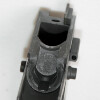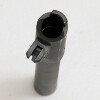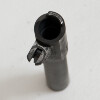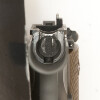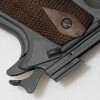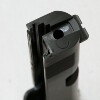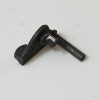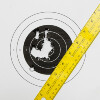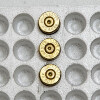ImperatorGray
Member
- Joined
- Jun 17, 2011
- Messages
- 177
Rambling preamble
More than a decade ago, Tisas 1911's were being imported as Regent R100's and getting good (if vague) reviews. I put hands on one and didn't get past the feel of the front strap. The dimensions were screwed up similarly to how the early Springfield's were. Possibly worse.
Today, there are Tisas 1911's being imported under the SDS name and, again, these are getting thumbs-up reviews. And again: A lot of the reviews are pretty vague. Some I read spent most of their ink on what a 1911 is, how good the USGI-ish version looks alongside Saving Private Ryan cosplay kit, or a PR recap of who works at SDS (Army vets and a former director at Kimber).
Per GunDigest:
Well, great. But we've all heard that story before, and the results don't always live up to the hype.
The 1911 was designed prior to the age of modern machine passes. This was the gunsmithing era of firearms manufacturing, when a lot of putting one together was mating pieces by hand, checking the fit, and then removing material and rechecking until it could pass the tests. There was a lot more skilled labor involved than there is in assembling most firearms today.
Which is why any 1911 retailing for under $400 seems likely to have gone down some shortcuts. Heck, a lot of 1911's in the $800-$1,200 range have taken some shortcuts, particularly when it comes to barrel fit. That's the kind of thing I want to know about when I read a 1911 review, not whether it exhibits hammer bite out of the box (anybody who's been around 1911's can tell by glancing at a photo how bad a given pistol will bite them) or how accurate a given shooter thinks it shoots.
I'll go ahead and throw that stuff in here, too, but for the most part this is going to the be review I wanted to read, as someone who has built a 1911 or two from bare frame up when he had more brains than money. (I have lost brain cells since, and make more money, so at this point I think I'd rather throw money at a custom somebody else builds than again spend that level of attention making something exactly how I want it.)
Initial impressions
Just looking over the various entries in the SDS/Tisas product line, it seemed that these were spec'd out by folks who actually understood what OG 1911 fanatics want in a pistol. That made the PR fluff referenced above sound plausible. Based on the offerings, they're not trying to win over those who think pistols are cool because they've seen them in flashy video games or John Wick movies. They're catering to those who appreciate the 1911's unparalleled user interface and its old-school utilitarianism. In other words, they knew to play to the platform's strengths.
The specific unit I purchased panders to the war-movie crowd.
Model: 1911A1 U.S. Army WG
UPC: 723551440186
The IAC Regents that didn't do it for me above were built on cast frames. SDS wants to make darn sure you know theirs are forged. And not just that, but that they're hardened before machining, so that they don't warp out of spec during the heat treat.

Cast frames are fine, but they don't lend themselves to front-strap checkering should the owner want that upgrade down the line. The front strap on my sample measures 0.060" thick, which should be adequate for adding 25lpi or 30lpi checkering.
The front strap, and the pistol as a whole minus the mainspring housing, feels like a Colt in the hand.
The MSH feels good - it doesn't feel like a Colt, because it's a compromise between Colt's arched A1 MSH and the original flat MSH. As such, it's the best-feeling arched MSH I've used given that I I prefer the feel of (and shoot better with) flat. At the range, there was no noticeable difference between how this worked for me versus a flat MSH. I'll be curious to see what my pal the arched-MSH fanatic thinks of it, but my guess is he won't notice the difference from his preferred shape either.
And speaking of hardening: The original military Colts were hardened only in small, key areas (after a period of being hardened not at all). I've seen gun-rag gushing on how this is an "exact" replica of a WWII pistol, but the truth is that this isn't exact and that exact isn't what you want anyway. (There are also lots of small cosmetic differences that will be less readily noticed than the rollmarks, particularly in the knurling. If you care, you can compare variations iterations of the originals here.)


The pistol comes with WWII-ish plastic grips that are ready for the addition of an ambidextrous safety and gorgeous WWI-ish double-diamond checkered walnut grips that are not. Also: Cleaning brush and cleaning rod, chamber flag, screwdown-type trigger guard lock, manual, bushing wrench, and two magazines.

Magazines
Supplied magazines are Check-Mate brand, drilled and tapped for bumpers, with quality anti-tilt, seven-round followers. Follower dimple is present to prevent last-round loss. As one would expect from Check-Mate, both springs had appropriate tension.
Thumb lock
The thumb lock aka manual safety is a make-or-break point with me. Far too many 1911's have either mushy or immovable thumb locks that need to be replaced or reprofiled by hand. The SDS has a lovely GI-style tabbed thumb lock with slight knurling. It snicks positively on safe and off safe exactly as it should.

Both thumb lock and grip safety pass engagement tests: With either applied, the sear does not creep whatever pressure is exerted on the trigger. (Easy 1911 safety checks are described here and here.)
Some pistols in this price range have skipped the detent notch. As shown below, it is present and properly executed on the SDS.

Trigger
The trigger has short steel shoe, has almost no vertical play, lacks excessive takeup and overtravel, and resets exactly as distinctly as a 1911 should.
In the spirit of old-school, the hammer is the type that can draw blood with a good high grip. Given how well-executed the trigger pull is, I'd hesitate to swap the hammer out for something less blood-thirsty and begin doing the trigger job over again. Instead, I'll note that the hammer spur is easily bobbed if one prefers the practical to the historical - and that SDS offers other models with Commander hammers or beavertails, either of which will tame the beast.
This sample's trigger pull averaged almost exactly 4lbs.

The trigger knurling is not as aesthetically pleasing as on the originals, but it provides the idea and a secure purchase for your finger pad. In practice, I consider this superior to the serrated trigger faces that have been the standard for some decades.

Firing pin
The firing pin is a .45-profile titanium example that has been anodized to mimic nitre blue aka fire blue. The blue is as conspicuous in real life as it is in the image three photos above.
The reduced mass of titanium is often used to pass muzzle-down drop tests for pre-Series 80 1911's. The half-cock notch of the 1911's hammer makes it safe from a drop jarring the sear out of the way, and the grip safety renders it drop-safe from the trigger's mass continuing abaft in a rear-first impact.
(This was the specific design purpose of the grip safety, and it is perfect for the job being as the same inertial forces acting upon the trigger will be acting upon the grip safety to maintain it in the "safe" position. This was particularly necessary given the high mass of the original long steel triggers in pre-A1 1911's. There's a reason Sig came out with a reduced-mass P320 trigger after all those public drop-fire complaints.)
The remaining potential drop fire was if the pistol were dropped directly on its muzzle. In that case, given enough height, a weak enough FP return spring, or a soft enough primer, a steel firing pin could continue traveling forward with enough force to set off the chambered round without anything else in the fire-control group having budged.
Colt's solution was to, in 1983, introduce the Series 80 pistol with a firing-pin block that had to be activated by the trigger. Nineteen-eleven heads, tending to be purists, lost their minds at the addition of four extra parts on the theory that they added additional fail points, ruined the trigger pull, or both.
The reality is that I have shot Series 80 Colts that had superior triggers to some very fine Series 70 pistols. (Series 70 being a term commonly applied to non-Series 80 1911's, though Series 70 originally referred to a specific barrel bushing that is no longer made. Colt has even reissued "Series 70" pistols that lacked Series 80 parts - and lacked Series 70 bushings to boot.) SDS wants to make sure you know they have opted out of the Series 80 nonsense, so it's easy to make a guess at why they would ship with titanium.
My preferred method of rendering a 1911 more drop safe is to use a 9mm firing pin in place of the .45 one, but in steel. The only light strike I have ever had in a 1911 was with the combination of hard primer and a titanium firing pin. As you can see in the image below, the slimmer volume of a 9mm pin will result in less mass when materials are the same.

The titanium pin above is only about 60 percent the mass of the steel one in 9mm. Naturally, I did the pencil test (actually a Bic pen test). The SDS passed it using the factory titanium pin, launching the Bic 42 inches straight up.
This indicates that SDS did not cheat getting a decent trigger pull by holding back on proper mainspring weight.
Extractor
The extractor is well-fit and not clocked.
Tension measured a hair over 15 ounces. Weigand recommends tuning to 25-28 ounces, but I have been satisfied over the years with the "shake" test: Field strip the slide, shove a live round up under the extractor, and shake the slide around to see if the round drops off. (It shouldn't.)
The extractor passed this test admirably.
(Continued in first reply.)
More than a decade ago, Tisas 1911's were being imported as Regent R100's and getting good (if vague) reviews. I put hands on one and didn't get past the feel of the front strap. The dimensions were screwed up similarly to how the early Springfield's were. Possibly worse.
Today, there are Tisas 1911's being imported under the SDS name and, again, these are getting thumbs-up reviews. And again: A lot of the reviews are pretty vague. Some I read spent most of their ink on what a 1911 is, how good the USGI-ish version looks alongside Saving Private Ryan cosplay kit, or a PR recap of who works at SDS (Army vets and a former director at Kimber).
Per GunDigest:
Essentially, SDS Imports sent their smart guys to TISAS and showed them how to build 1911s the right way. Two of the engineers at SDS Imports, Scott Huff and Gaines Davis, rotate between Knoxville, Tennessee, and Turkey to make sure TISAS is building 1911s to the high standards SDS Imports have set. These engineers literally look over the shoulders of the workers at TISAS and have instituted high quality control standards that must be met before the handguns are shipped to the United States.
Well, great. But we've all heard that story before, and the results don't always live up to the hype.
The 1911 was designed prior to the age of modern machine passes. This was the gunsmithing era of firearms manufacturing, when a lot of putting one together was mating pieces by hand, checking the fit, and then removing material and rechecking until it could pass the tests. There was a lot more skilled labor involved than there is in assembling most firearms today.
Which is why any 1911 retailing for under $400 seems likely to have gone down some shortcuts. Heck, a lot of 1911's in the $800-$1,200 range have taken some shortcuts, particularly when it comes to barrel fit. That's the kind of thing I want to know about when I read a 1911 review, not whether it exhibits hammer bite out of the box (anybody who's been around 1911's can tell by glancing at a photo how bad a given pistol will bite them) or how accurate a given shooter thinks it shoots.
I'll go ahead and throw that stuff in here, too, but for the most part this is going to the be review I wanted to read, as someone who has built a 1911 or two from bare frame up when he had more brains than money. (I have lost brain cells since, and make more money, so at this point I think I'd rather throw money at a custom somebody else builds than again spend that level of attention making something exactly how I want it.)
Initial impressions
Just looking over the various entries in the SDS/Tisas product line, it seemed that these were spec'd out by folks who actually understood what OG 1911 fanatics want in a pistol. That made the PR fluff referenced above sound plausible. Based on the offerings, they're not trying to win over those who think pistols are cool because they've seen them in flashy video games or John Wick movies. They're catering to those who appreciate the 1911's unparalleled user interface and its old-school utilitarianism. In other words, they knew to play to the platform's strengths.
The specific unit I purchased panders to the war-movie crowd.
Model: 1911A1 U.S. Army WG
UPC: 723551440186
The IAC Regents that didn't do it for me above were built on cast frames. SDS wants to make darn sure you know theirs are forged. And not just that, but that they're hardened before machining, so that they don't warp out of spec during the heat treat.

Cast frames are fine, but they don't lend themselves to front-strap checkering should the owner want that upgrade down the line. The front strap on my sample measures 0.060" thick, which should be adequate for adding 25lpi or 30lpi checkering.
The front strap, and the pistol as a whole minus the mainspring housing, feels like a Colt in the hand.
The MSH feels good - it doesn't feel like a Colt, because it's a compromise between Colt's arched A1 MSH and the original flat MSH. As such, it's the best-feeling arched MSH I've used given that I I prefer the feel of (and shoot better with) flat. At the range, there was no noticeable difference between how this worked for me versus a flat MSH. I'll be curious to see what my pal the arched-MSH fanatic thinks of it, but my guess is he won't notice the difference from his preferred shape either.
And speaking of hardening: The original military Colts were hardened only in small, key areas (after a period of being hardened not at all). I've seen gun-rag gushing on how this is an "exact" replica of a WWII pistol, but the truth is that this isn't exact and that exact isn't what you want anyway. (There are also lots of small cosmetic differences that will be less readily noticed than the rollmarks, particularly in the knurling. If you care, you can compare variations iterations of the originals here.)


The pistol comes with WWII-ish plastic grips that are ready for the addition of an ambidextrous safety and gorgeous WWI-ish double-diamond checkered walnut grips that are not. Also: Cleaning brush and cleaning rod, chamber flag, screwdown-type trigger guard lock, manual, bushing wrench, and two magazines.
Magazines
Supplied magazines are Check-Mate brand, drilled and tapped for bumpers, with quality anti-tilt, seven-round followers. Follower dimple is present to prevent last-round loss. As one would expect from Check-Mate, both springs had appropriate tension.
Thumb lock
The thumb lock aka manual safety is a make-or-break point with me. Far too many 1911's have either mushy or immovable thumb locks that need to be replaced or reprofiled by hand. The SDS has a lovely GI-style tabbed thumb lock with slight knurling. It snicks positively on safe and off safe exactly as it should.
Both thumb lock and grip safety pass engagement tests: With either applied, the sear does not creep whatever pressure is exerted on the trigger. (Easy 1911 safety checks are described here and here.)
Some pistols in this price range have skipped the detent notch. As shown below, it is present and properly executed on the SDS.

Trigger
The trigger has short steel shoe, has almost no vertical play, lacks excessive takeup and overtravel, and resets exactly as distinctly as a 1911 should.
In the spirit of old-school, the hammer is the type that can draw blood with a good high grip. Given how well-executed the trigger pull is, I'd hesitate to swap the hammer out for something less blood-thirsty and begin doing the trigger job over again. Instead, I'll note that the hammer spur is easily bobbed if one prefers the practical to the historical - and that SDS offers other models with Commander hammers or beavertails, either of which will tame the beast.
This sample's trigger pull averaged almost exactly 4lbs.

The trigger knurling is not as aesthetically pleasing as on the originals, but it provides the idea and a secure purchase for your finger pad. In practice, I consider this superior to the serrated trigger faces that have been the standard for some decades.

Firing pin
The firing pin is a .45-profile titanium example that has been anodized to mimic nitre blue aka fire blue. The blue is as conspicuous in real life as it is in the image three photos above.
The reduced mass of titanium is often used to pass muzzle-down drop tests for pre-Series 80 1911's. The half-cock notch of the 1911's hammer makes it safe from a drop jarring the sear out of the way, and the grip safety renders it drop-safe from the trigger's mass continuing abaft in a rear-first impact.
(This was the specific design purpose of the grip safety, and it is perfect for the job being as the same inertial forces acting upon the trigger will be acting upon the grip safety to maintain it in the "safe" position. This was particularly necessary given the high mass of the original long steel triggers in pre-A1 1911's. There's a reason Sig came out with a reduced-mass P320 trigger after all those public drop-fire complaints.)
The remaining potential drop fire was if the pistol were dropped directly on its muzzle. In that case, given enough height, a weak enough FP return spring, or a soft enough primer, a steel firing pin could continue traveling forward with enough force to set off the chambered round without anything else in the fire-control group having budged.
Colt's solution was to, in 1983, introduce the Series 80 pistol with a firing-pin block that had to be activated by the trigger. Nineteen-eleven heads, tending to be purists, lost their minds at the addition of four extra parts on the theory that they added additional fail points, ruined the trigger pull, or both.
The reality is that I have shot Series 80 Colts that had superior triggers to some very fine Series 70 pistols. (Series 70 being a term commonly applied to non-Series 80 1911's, though Series 70 originally referred to a specific barrel bushing that is no longer made. Colt has even reissued "Series 70" pistols that lacked Series 80 parts - and lacked Series 70 bushings to boot.) SDS wants to make sure you know they have opted out of the Series 80 nonsense, so it's easy to make a guess at why they would ship with titanium.
My preferred method of rendering a 1911 more drop safe is to use a 9mm firing pin in place of the .45 one, but in steel. The only light strike I have ever had in a 1911 was with the combination of hard primer and a titanium firing pin. As you can see in the image below, the slimmer volume of a 9mm pin will result in less mass when materials are the same.

The titanium pin above is only about 60 percent the mass of the steel one in 9mm. Naturally, I did the pencil test (actually a Bic pen test). The SDS passed it using the factory titanium pin, launching the Bic 42 inches straight up.
This indicates that SDS did not cheat getting a decent trigger pull by holding back on proper mainspring weight.
Extractor
The extractor is well-fit and not clocked.
Tension measured a hair over 15 ounces. Weigand recommends tuning to 25-28 ounces, but I have been satisfied over the years with the "shake" test: Field strip the slide, shove a live round up under the extractor, and shake the slide around to see if the round drops off. (It shouldn't.)
The extractor passed this test admirably.
(Continued in first reply.)
Last edited:



